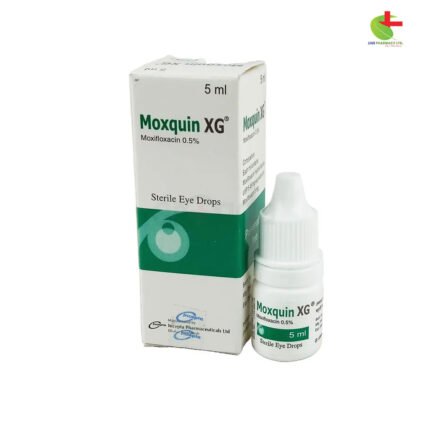Moxquin Eye Drop
160.00৳ Drop (5ml)
- Moxquin Ophthalmic Solution is an effective treatment for bacterial conjunctivitis caused by various susceptible microorganisms.
- Designed for both eye drops and ointment application, it offers targeted relief and prevents postoperative bacterial endophthalmitis.
- This solution utilizes Moxifloxacin, an antibiotic that disrupts bacterial DNA replication.
 Brand
Brand
|
Incepta Pharmaceuticals Ltd |
|---|---|
 Generics
Generics
|
Moxifloxacin Hydrochloride |
 Type
Type
|
Ophthalmic Solution |
Indications
Moxquin Ophthalmic Solution is specifically designed to treat bacterial conjunctivitis caused by sensitive strains of the following microorganisms:
- Aerobic Gram-Positive Bacteria: Includes Corynebacterium species, Micrococcus luteus, Staphylococcus aureus, Staphylococcus epidermidis, Staphylococcus haemolyticus, Staphylococcus hominis, Staphylococcus warneri, Streptococcus pneumoniae, and the Streptococcus viridans group.
- Aerobic Gram-Negative Bacteria: Targets Acinetobacter lwoffii, Haemophilus influenzae, and Haemophilus parainfluenzae.
- Other Pathogens: Effective against Chlamydia trachomatis.
Additionally, Moxquin is an effective intraocular antibiotic for preventing postoperative bacterial endophthalmitis.
Use this medication only as directed by a registered healthcare professional.
Pharmacology
Moxifloxacin exhibits its antimicrobial effects by inhibiting topoisomerase II (DNA gyrase) and topoisomerase IV—key enzymes involved in bacterial DNA replication, transcription, and repair. Topoisomerase IV also plays a crucial role in the proper segregation of chromosomal DNA during bacterial cell division.
Dosage & Administration
- Eye Drops: Instill one drop into the affected eye three times daily for a duration of seven days.
- Eye Ointment: Apply a thin, even layer to the affected eye three times daily for the first two days; then, reduce application to twice daily for the next five days, or as recommended by your physician.
- Intraocular Injection: Administer Moxifloxacin as a 0.2-0.4 ml dose prior to ocular surgery via the intraocular route, with the final dosage determined by your doctor.
Always follow the advice of a registered healthcare professional regarding medication usage.
Interactions
Currently, drug-drug interaction studies for Moxquin have not been conducted. In vitro findings suggest that Moxquin does not inhibit key cytochrome P450 isozymes (CYP3A4, CYP2D6, CYP2C9, CYP2C19, or CYP1A2), indicating a low likelihood of affecting the pharmacokinetics of drugs metabolized by these enzymes.
Contraindications
Moxifloxacin Hydrochloride ophthalmic solution is contraindicated in individuals with a known hypersensitivity to Moxifloxacin, other quinolone antibiotics, or any components within this formulation.
Side Effects
Common ocular side effects may include conjunctivitis, reduced visual acuity, dry eyes, keratitis, ocular discomfort, hyperemia, pain, itching, subconjunctival hemorrhage, and tearing—occurring in approximately 1-6% of users. Non-ocular side effects reported at a frequency of 1-4% include fever, increased cough, infections, otitis media, pharyngitis, rash, and rhinitis.
Pregnancy & Lactation
Due to a lack of adequate and controlled studies in pregnant women, Moxifloxacin Hydrochloride ophthalmic solution should be administered during pregnancy only if the potential benefits outweigh the risks to the fetus. While Moxifloxacin levels in human milk have not been studied, it is assumed that it may be excreted in breast milk. Caution is advised when this medication is given to nursing mothers.
Precautions & Warnings
As with other anti-infective treatments, prolonged use may lead to the overgrowth of non-susceptible organisms, including fungi. If a superinfection occurs, discontinue use and consider alternative therapies. It is recommended that a thorough examination, potentially with magnification (e.g., slit lamp biomicroscopy) and fluorescein staining, be performed when clinically indicated. Patients showing signs of bacterial conjunctivitis should refrain from wearing contact lenses.
Therapeutic Class
Ophthalmic Antibacterial Drugs
Storage Conditions
Store below 25°C in a cool, dry place, away from light. Keep out of reach of children. Avoid touching the dropper tip to any surfaces to prevent contamination. Do not use after one month from the first opening.













Reviews
There are no reviews yet.